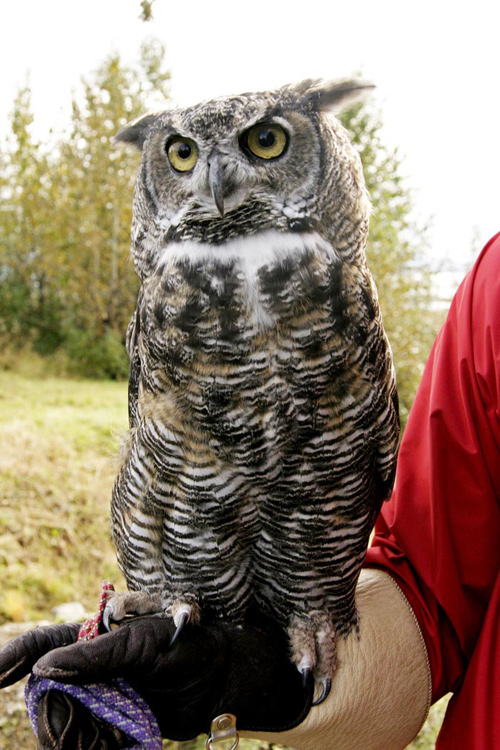The great horned owl is a large owl and the heaviest owl in North America. Their feathers are a dark brown mixed with white, black and tan. They have large feather ear tufts which are called plumicorns and are not actually related to ears or hearing at all. Their eyes are very large and yellow. They have feathers on their legs and feet. The adults can weigh from 2 to 5 pounds and their wingspans are over 4 feet.
Owls fly very quietly. They have specially-designed, sound-absorbing feathers that allow them to accomplish silent flight. Their feathers tend to absorb high-frequency sound, and in addition the leading edges of their wing feathers have a fringe called flutings that both aid in stable flight and muffle the sound of air moving over the wing. Feathers trailing from the back of their wings mitigate sound waves produced by air flowing over the wing and off of the back.
The most commonly heard call of the great horned owl is a hoot that has been described as "hoo hoooo hoo hoo" that may be repeated several times. Click on the link under the picture for an example. You often hear a nearby owl calling to be answered by a more distant owl. This is often an exchange between a male and a female. Great horned owls also clack their beaks.
Great horned owls are widely distributed and are permanent residents across the entire US. They are found in all but the most northern parts of Canada and Alaska and dip into the northern region of Mexico. They are not migratory, but if food becomes scarce they will move to other regions to find more.
Great horned owls are found throughout Connecticut.
These owls are very adaptable. They will live in dense forest, open desert, along cliffs and in city park settings. They are nocturnal.
Great horned owls eat mammals such as rodents, rabbits and smaller owls. They are a major predator of the barred owl and will regularly eat skunks. They have been known to take animals as large as woodchucks or geese. They will prey on small pets. A friend of mine just recently saw a great horned owl flying overhead with a white, collared cat in its claws. (Another good reason for not allowing pets to roam.) They tend to dive down silently on their prey and capture it with their strong, sharp talons. They swallow their prey whole if it is small enough but will tear large prey into manageable chunks. Like other owls they later regurgitate undigestible parts like bones and hair in a compact lump called an owl pellet.
These owls start breeding early. They are often courting in December or January. Great horned owls have produced 2 to 4 eggs by February. Research has shown that they can incubate their eggs even when the temperature falls as low as -27 degrees F. They use the old nests of other creatures instead of building their own. The nests built by red-tailed hawks, crows, or squirrels are common choices. Eggs hatch after about a month and the female provides most of the care for the chicks. The lifespan of great horned owls is about 5 to 15 years in the wild.
